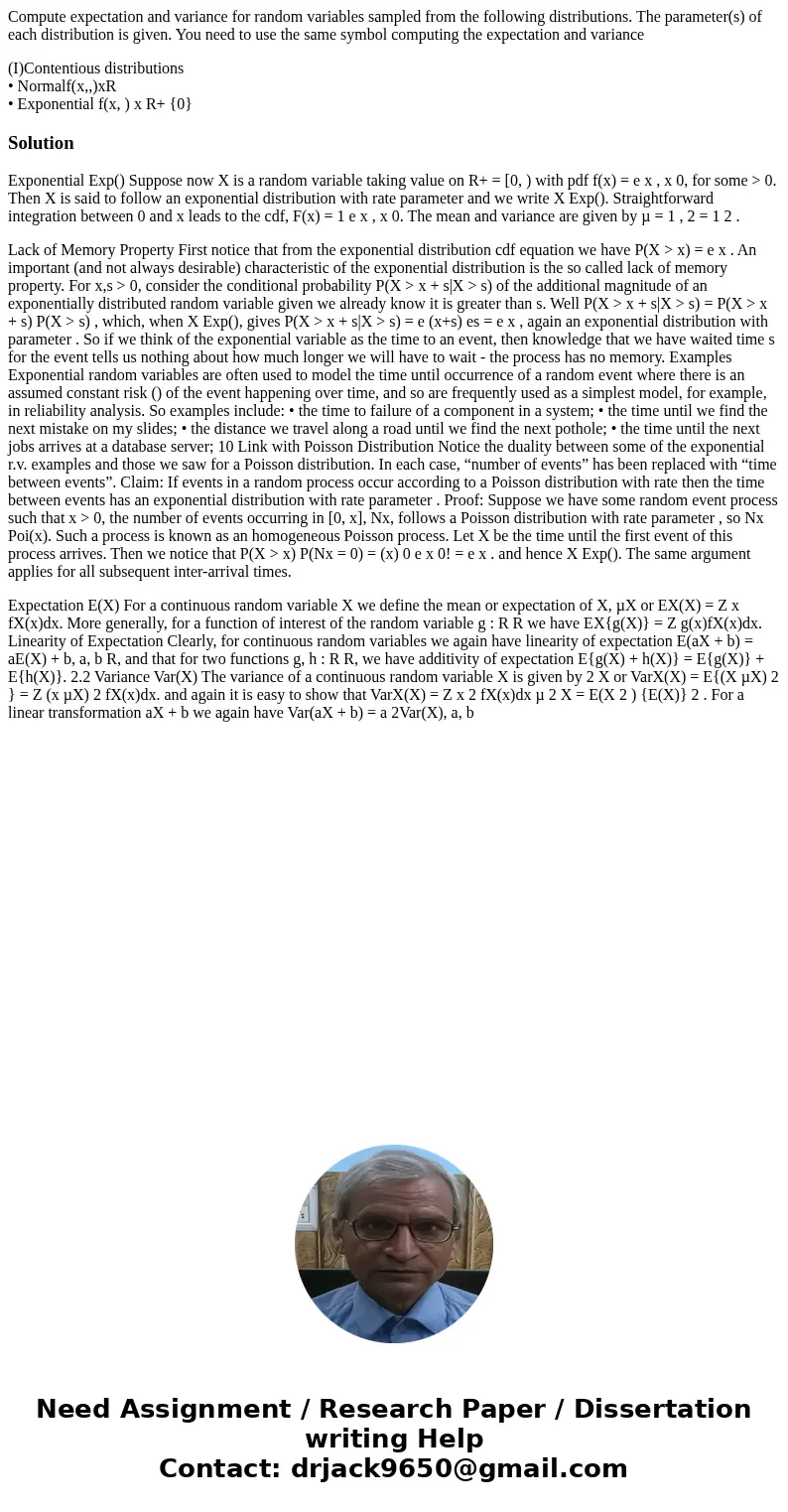Compute expectation and variance for random variables sample
Compute expectation and variance for random variables sampled from the following distributions. The parameter(s) of each distribution is given. You need to use the same symbol computing the expectation and variance
(I)Contentious distributions
• Normalf(x,,)xR
• Exponential f(x, ) x R+ {0}
Solution
Exponential Exp() Suppose now X is a random variable taking value on R+ = [0, ) with pdf f(x) = e x , x 0, for some > 0. Then X is said to follow an exponential distribution with rate parameter and we write X Exp(). Straightforward integration between 0 and x leads to the cdf, F(x) = 1 e x , x 0. The mean and variance are given by µ = 1 , 2 = 1 2 .
Lack of Memory Property First notice that from the exponential distribution cdf equation we have P(X > x) = e x . An important (and not always desirable) characteristic of the exponential distribution is the so called lack of memory property. For x,s > 0, consider the conditional probability P(X > x + s|X > s) of the additional magnitude of an exponentially distributed random variable given we already know it is greater than s. Well P(X > x + s|X > s) = P(X > x + s) P(X > s) , which, when X Exp(), gives P(X > x + s|X > s) = e (x+s) es = e x , again an exponential distribution with parameter . So if we think of the exponential variable as the time to an event, then knowledge that we have waited time s for the event tells us nothing about how much longer we will have to wait - the process has no memory. Examples Exponential random variables are often used to model the time until occurrence of a random event where there is an assumed constant risk () of the event happening over time, and so are frequently used as a simplest model, for example, in reliability analysis. So examples include: • the time to failure of a component in a system; • the time until we find the next mistake on my slides; • the distance we travel along a road until we find the next pothole; • the time until the next jobs arrives at a database server; 10 Link with Poisson Distribution Notice the duality between some of the exponential r.v. examples and those we saw for a Poisson distribution. In each case, “number of events” has been replaced with “time between events”. Claim: If events in a random process occur according to a Poisson distribution with rate then the time between events has an exponential distribution with rate parameter . Proof: Suppose we have some random event process such that x > 0, the number of events occurring in [0, x], Nx, follows a Poisson distribution with rate parameter , so Nx Poi(x). Such a process is known as an homogeneous Poisson process. Let X be the time until the first event of this process arrives. Then we notice that P(X > x) P(Nx = 0) = (x) 0 e x 0! = e x . and hence X Exp(). The same argument applies for all subsequent inter-arrival times.
Expectation E(X) For a continuous random variable X we define the mean or expectation of X, µX or EX(X) = Z x fX(x)dx. More generally, for a function of interest of the random variable g : R R we have EX{g(X)} = Z g(x)fX(x)dx. Linearity of Expectation Clearly, for continuous random variables we again have linearity of expectation E(aX + b) = aE(X) + b, a, b R, and that for two functions g, h : R R, we have additivity of expectation E{g(X) + h(X)} = E{g(X)} + E{h(X)}. 2.2 Variance Var(X) The variance of a continuous random variable X is given by 2 X or VarX(X) = E{(X µX) 2 } = Z (x µX) 2 fX(x)dx. and again it is easy to show that VarX(X) = Z x 2 fX(x)dx µ 2 X = E(X 2 ) {E(X)} 2 . For a linear transformation aX + b we again have Var(aX + b) = a 2Var(X), a, b

 Homework Sourse
Homework Sourse